
28
Proceedings of the 18
th
International Conference on Soil Mechanics and Geotechnical Engineering, Paris 2013
Proceedings of the 18
th
International Conference on Soil Mechanics and Geotechnical Engineering, Paris 2013
10 THE STOREGGA SLIDE
10.1
Description of the slide
The Storegga slide in the Norwegian Sea is one of the largest
known submarine slides on earth. The head wall of the slide
scar is 300 km long. About 3500 km
3
failed from the shelf edge,
sliding out as far as 800 km in water depths as deep as 3000 m
(Fig. 31). The failure started probably some 200 km downhill
and crept rapidly up slope as the headwalls failed and slipped
down towards the deep ocean floor. At the same time, the mass
movement generated a huge tsunami that reached the shores of,
among others, Norway, Scotland and the Shetland Islands. The
sizable gas resources at the Ormen Lange filed are located in the
scar left by the giant underwater slide, beneath a relatively cha-
otic terrain created by the slide 8,200 years ago.
The Storegga slide was the subject of a large integrated study
for the safe development of the deepwater gas field on the North
Atlantic continental margin. In addition, the SEABED project
was launched by the partners of the Ormen Lange field (Norsk
Hydro ASA, A/S Norske Shell, Petoro AS, Statoil ASA, BP
Norge AS and Esso Exploration and Production Norway AS)
with the aim of improving the knowledge of the seafloor mor-
phology, the shallow geology, and the potential hazards and
risks associated with the area. The project is an excellent exam-
ple of the interweaving of research and practice and the coop-
eration of academia and industry.
Figure 31. The Storegga slide, 8,200 years BP.
The design questions that needed to be answered were: (1)
Can a new large slide, capable of generating a tsunami, occur
again, either due to natural processes or through the activities
required for the exploitation of the field; and (2) Can smaller
slides be triggered on the steep slopes created by the Storegga
slide, and if so, would they endanger the planned offshore in-
stallations to recover the gas resources.
10.2
Soil parameters
The reader is referred to Solheim
et al
(2005a; b); Kvalstad
et al
(2005 a;b); Kvalstad (2007); Nadim
et al
(2005b) and the spe-
cial issue of Marine and Petroleum Geology (Volume 22, No 1
and 2) for an account of the slide and a summary of the studies
by the parties involved.
10.3
Analysis of the landslide
Based on the studies in the SEABED project, the triggering and
sliding mechanics used the observed morphology and the geo-
technical characteristics of the sediments. The average slope
angle of the seafloor was only 0.6 to 0.7°. The geotechnical
properties indicated shear strengths far above those required to
explain a failure. However, the geophysical observations, espe-
cially seismic reflections profiles in the upper parts of the slide
scar, provided strong indications that the failure developed ret-
rogressively (Fig. 32). Using the retrogressive slide model as
working hypothesis, several scenarios of sources of excess pore
pressures were considered, including (1) earthquake-induced
shear strain generating excess pore pressures, (2) melting of gas
hydrates releasing methane gas and water, (3) shear strain-
induced contraction with pore pressure generation and strain-
softening, and (4) rapid deposition. The studies concluded that
the most likely trigger was an earthquake destabilizing a locally
steep slope in the lower part of the present slide scar. The retro-
gressive process continued up-slope until conditions improved
with stronger layers associated with the consolidation of the
shelf sediments during glacial times. Once the instability
started, excess pore pressures already generated during rapid
sedimentation under the last glaciation were an important con-
tribution to the large slope failure (Bryn
et al
2005).
Figure 32. Bathymetry and seismic profiles in the upper headwall at
Ormen Lange (Kvalstad
et al
2005a).
Excess pore pressures still exist at the site, as demonstrated by
in situ
monitoring (Strout and Tjelta 2005). The excess pore
pressures recorded in several locations and at several strati-
graphic levels support the depositional role in the Storegga fail-
ure proposed by Bryn
et al
2005.
The seismic studies by Bungum
et al
2005 showed that
strong, isostatically induced earthquakes had occurred earlier
along the mapped faults at the site. Stress transfer induced
earthquakes had also probably taken place earlier. Bungum
et al
also suggested that multiple strong earthquakes with extended
duration most likely occurred and could be the potential trigger
for the Storegga slope instability.
The tsunami generating potential of submarine slides is to-
day widely recognized. The tsunami studies indicated that the
field observations of run-up fitted will the retrogressive slide
model with a velocity of 25-30 m/s, and time lags of 15-20 s be-
tween individual slide blocks (Bondevik
et al
2005). The slide
mass involved in the tsunami generation modelwas 2,400 km
3
.


